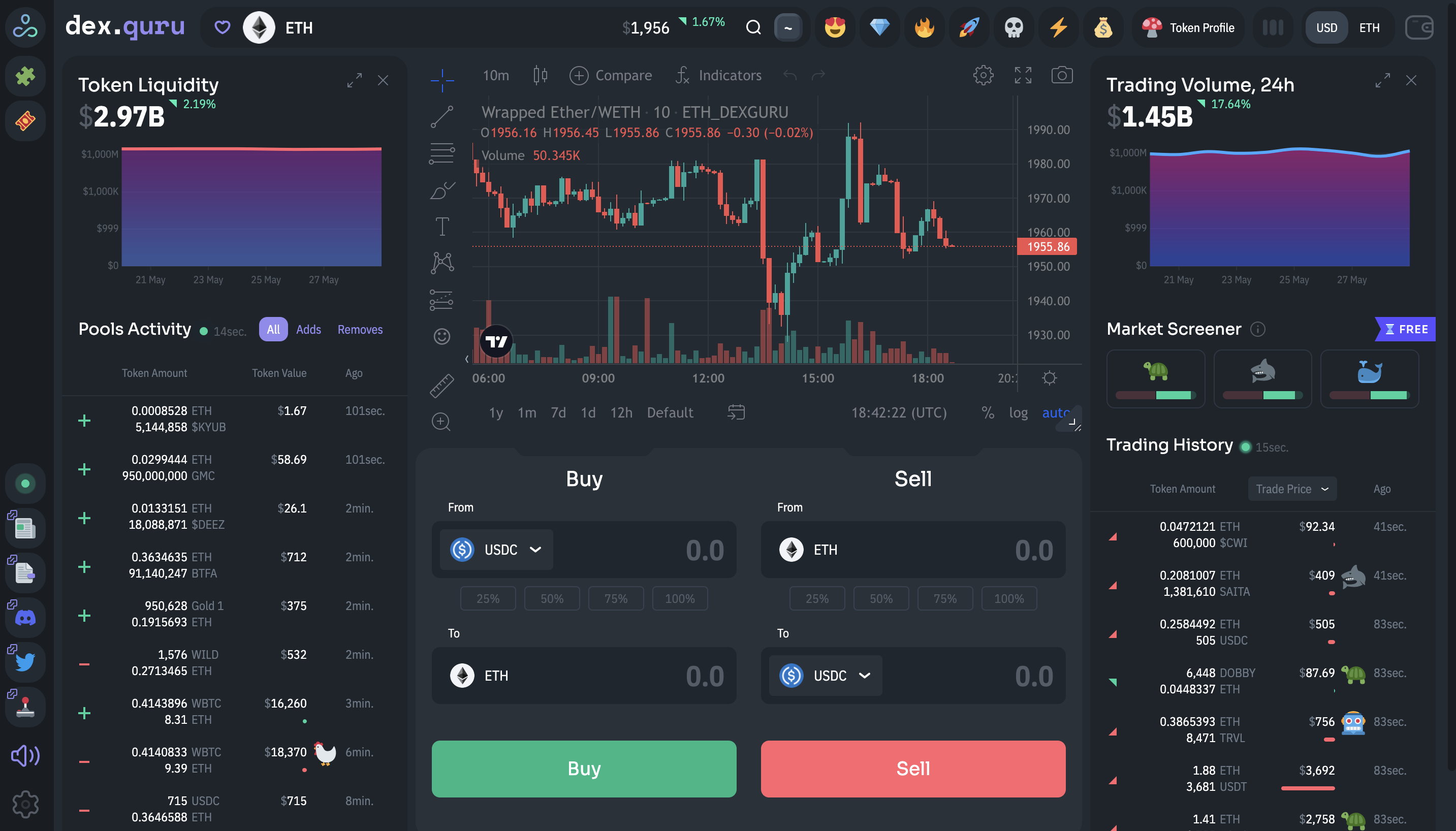The DexGuru platform provides on-chain analytics, a swap tool, multiple chains, and DEXs, there is a lot to process for any level trader. This article will address any confusion for newcomers to DexGuru and seasoned members of the GuruDAO bootstrap phase alike.
Whether you’re a newcomer to DexGuru or a seasoned member of the GuruDAO bootstrap phase, the DexGuru platform can be complex. With on-chain analytics, a swap tool, multiple chains, and DEXs, there is a lot to process for any level trader. We’ve decided to compile this article to address any confusion regarding the DexGuru trading terminal.
What is DexGuru?
Put simply, DexGuru offers data. We work hard to gather all relevant on-chain data to then present it to DexGuru users in a helpful and efficient way for DeFi traders. Data is collected from eight EVM compatible chains so DeFi traders on Avalanche, Ethereum, Arbitrum and others can enjoy the same trading experience when analyzing their favourite tokens. This is done by monitoring many unique DEXs and their pools for liquidity changes, trades, and price movements.
To complete the all-in-one trading experience, DexGuru also offers a swap tool. The swap tool allows users to buy and sell spot assets directly from the DexGuru terminal without using a separate protocol. Transactions are collected and processed by the 0x API, offering the best exchange rates for your trades.
Using the foundations of on-chain data, the DexGuru team (A.K.A. Dev sub-DAO) continues to find more efficient and effective ways of presenting this data. The multi-chart trading tool, your favourite tokens tab, and your wallet breakdown compile on-chain activity to help you, the trader.
Our mission is to continue gathering more data and offering more tools for the DeFi trader to ensure there is no need to go elsewhere for a DeFi terminal.

How to use DexGuru
The best part about DeFi is that you can participate with no intermediary blockades! At DexGuru, we significantly align ourselves with the web3 values that brought us all to the space, but we have some helpful suggestions.
Charting is the most basic tool that is available on the platform. Users can search any of the tokens listed on DexGuru, view different time frames, overlay charts, and use indicators for the whole trading experience. More advanced users can even use the newly released multi-chart feature to simultaneously view up to nine different charts.
Whether the price of your favourite DeFi token is rising or falling, one question comes to mind, who is moving the market? With the Market Screener tool, traders have access to that information instantly. The Market Screener displays trading activity for each token listed on the platform. View trades made by whales, sharks, turtles or bots by reading the symbol next to each trade.
An A.M.M. can’t process DeFi swaps without liquidity, so monitoring the activity for liquidity pools is extremely important. The DexGuru trading terminal broadcasts all pool activity for the token of your choice, and traders can see the liquidity added/removed updated every 30 seconds. For simplicity, There are elephant, tiger and chicken symbols to represent how large of a market participant is moving their liquidity.
What is DexGuru not?
Given the broad scope of DexGuru’s services, there can be many misconceptions about the platform; let’s address a few.
DEX: The swap tool on the DexGuru platform uses the 0x API to handle trade volume, meaning that we at DexGuru DO NOT execute trades. The swap feature is put in place for the convenience of our users as DexGuru does not have any smart contracts of our own, and therefore we can also not revert or cancel transactions on our end.
Fee Taker: As mentioned above, the trading terminal uses the 0x API, so there is no extra fee taken for swaps, contrary to Metamask, which takes a 0.875% fee for the convenience of swapping inside your wallet. There is simply a tip option during the swap process if you want to show your support to the DexGuru team and DAO.
Token Authenticator: Once DexGuru begins collecting liquidity pool data from a new DEX, all tokens on that DEX are automatically indexed and are, therefore, visible on the DexGuru trading terminal. Some of these tokens may be scams, rug pulls and projects with poor values. Unfortunately, we can not and will not be blacklisting tokens as there is too much information to analyze. The user is responsible for doing their research before investing in any asset visible on DexGuru.
New Features
We’ve received many requests for new features, including NFT compatibility, limit orders and cross-chain swaps. These requests do not go unnoticed, and Dev sub-DAO will be providing updates on all product progress.




